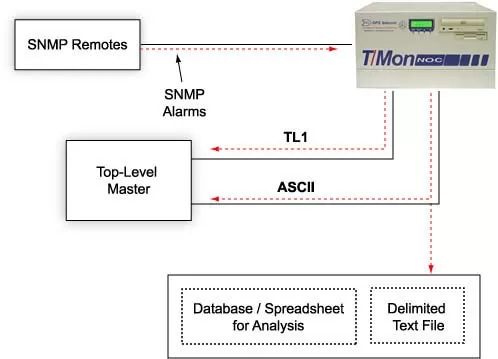Download our free SNMP White Paper. Featuring SNMP Expert Marshall DenHartog.
This guidebook has been created to give you the information you need to successfully implement SNMP-based alarm monitoring in your network.
1-800-693-0351
Have a specific question? Ask our team of expert engineers and get a specific answer!
Sign up for the next DPS Factory Training!

Whether you're new to our equipment or you've used it for years, DPS factory training is the best way to get more from your monitoring.
Reserve Your Seat Today
You can do more with SNMP data than just send it to an SNMP manager. Protocol mediation lets you translate data from your SNMP remotes into other formats for other uses. The T/Mon NOC can receive SNMP alarm messages (traps) and forward them in TL1 or as ASCII text. This function supports two key applications.
Protocol mediation is vitally important if you use network monitoring equipment from different vendors. For example, let's say you have an existing non-SNMP master that monitors most of your network, but you also need to monitor SNMP devices and remotes. Protocol mediation allows you to consolidate the SNMP data with the rest of your monitoring. Consolidating all your monitoring onto one platform is easier and more reliable than running two different monitoring systems, and it saves you the cost of buying a separate SNMP manager.
The T/Mon NOC is a monitoring platform as well as a mediation device, so you can use it for simultaneous viewing and forwarding of alarms. This is particularly useful if you need to have a monitoring console for managing a regional network and you also want to forward regional alarm data to a primary master.
You can't have human beings in your NOC watching your monitoring screens 24 hours a day, 365 days a year. But network threats can happen at any time. How do you track network problems when the NOC staff is away? ASCII alarm forwarding provides an ideal way of monitoring network activity when the NOC is unmanned. The T/Mon NOC can output alarm data to any ASCII-based monitoring or recording device.
Alarm data contains a wealth of information about what's going on in your network. Analysis of your alarm data can tell you where, when, and under what conditions network problems usually occur, identify network usage trends, and help you anticipate and prevent future network problems.
In the application shown here, the T/Mon NOC receives SNMP alarm messages, mediates them to ASCII text, and exports the information as a delimited text file. The alarm information in the text file can then be imported into a database or spreadsheet, and from there you can graph or tabulate it for analysis.